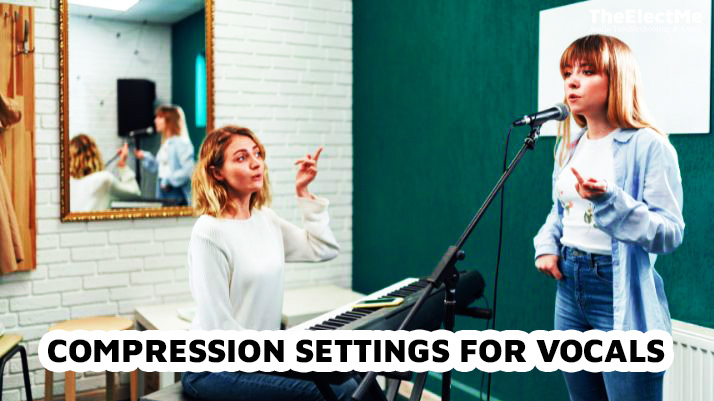Compression settings for vocals involve adjusting the ratio, threshold, attack, and release of a compressor to achieve the desired sound. It is an essential tool for any audio engineer or musician looking to improve the quality of their recordings. But how to do it with proper and correct instructions that will benefit you?
Forget to worry about your vocals being too quiet or loud in your recordings anymore. Let’s grab a cup of coffee and dive in.

Why Is It Crucial To Consider Compression Settings For Vocals?
Compression is a technique used in audio production to control the volume of audio signals. It decreases the dynamic range of a sound, which is the gap between the loudest and softest parts. The compression evens out performance and enhances sound consistency.
Regarding vocals, compression plays a crucial role in achieving a professional sound. Controlling the vocal performance’s dynamic range ensures balanced volume throughout. The results polished vocal sound that sits well in the mix.
Overall, compression is an essential tool for achieving a professional vocal sound. It helps control the vocals’ dynamics and enhances their overall impact in the mix. Let’s move to the next step and learn how to set up compression settings for vocals.
How To Set Up Compression Settings For Vocals? Step By Step Guide
As a content creator, you want your vocals to sound perfect. Setting up the right compression settings is an important step in achieving that. Here are some steps to help you set up compression for your vocals:
Step No 1: Selecting The Right Ratio
When selecting the right compression ratio for vocals, it’s important to understand the effects of different ratios on the sound. Here are a few commonly used compression ratios and their effects:
2:1 Ratio
The 2:1 ratio is considered a gentle compression setting. It means that for every 2 dB of input level above the threshold, the output level will only increase by 1 dB. A 2:1 ratio helps to smooth out minor volume variations in the vocal performance without drastically altering the dynamics.
3:1 Ratio
This ratio provides a slightly more noticeable compression effect. For every 3 dB of input level above the threshold, the output level increases by 1 dB. A 3:1 ratio helps to even out the vocal performance while preserving some natural dynamics.

7:1 Ratio
The 7:1 ratio falls into the realm of heavy compression. With a 7:1 ratio, for every 7 dB of input level above the threshold, the output level only increases by 1 dB. This high ratio effectively reduces the dynamic range, producing a more consistent and “in your face” vocal sound.
8:1 Ratio
This ratio is typically associated with extreme compression. With an 8:1 ratio, for every 8 dB of input level above the threshold, the output level increases by only 1 dB. An 8:1 ratio heavily compresses the vocals, creating a highly consistent and compressed sound.
A gentler ratio, like 2:1 or 3:1, may be suitable for maintaining a more natural and expressive vocal performance.
Step No 2: Setting The Attack Time
The attack time plays a crucial role in shaping the initial transients of vocals. It determines how quickly the compressor responds to the audio signal once it crosses the threshold.
A fast attack time can significantly impact the overall vocal sound. It allows the compressor to engage and reduce the level of the transients quickly. The result is a more controlled and consistent vocal performance.
On the other hand, a slow attack time can preserve the initial transients of the vocals. Slower attack times are ideal for vocals in acoustic or intimate genres, giving a transparent and dynamic sound.
Generally, 15ms is a good starting point for vocals, but this can vary depending on the intensity of the performance. Experiment with different attack times to find the perfect balance for your vocals.

Step No 3: Adjusting The Release Time
A compressor’s release time dictates how quickly it reduces gain after the audio signal exceeds the threshold. It plays a crucial role in shaping the envelope of the compressed sound.
A shorter release time can result in a more aggressive and pronounced compression effect. On the other hand, a longer release time can lead to a more transparent and natural-sounding compression. Longer release times are often preferred when a smoother, more organic vocal sound is desired.
Generally, a release time of around 40ms is a good starting point for vocals. Like attack time, experiment to find the optimal setting for your vocal performance.
Step No 4: Adjusting The Threshold
Setting the threshold for compression is crucial in achieving the desired vocal sound. The threshold level decides when the compressor engages and reduces the gain on the vocals.
If the threshold is too low, the compressor engages too often, reducing vocal dynamics. On the other hand, if the threshold is set too high, the compressor may need to engage more.
The result is that the dynamic range of the vocals may remain uncontrolled and inconsistent. Generally, a good starting point for the threshold setting is around -24 dB.
Step No 5: Gain Reduction And Knee
Gain reduction is the amount by which the compressor reduces the gain of the signal. This is where we start to see the effects of compression on vocals. The gain reduction should be 2-3 dB at most, with anything above 6 dB being excessive.
The knee setting determines how abruptly or smoothly the compressor engages and disengages. A hard knee setting provides an abrupt transition from no compression to full compression. To achieve natural-sounding vocals, it’s recommended to use a soft knee setting.

Step No 6: Adjusting Makeup Gain
Makeup gain is an essential tool in the compression process. It is used to compensate for the volume reduction caused by compression. When a compressor applies gain reduction to a signal, it reduces the overall level and can result in a quieter sound.
Makeup gain balances and levels compressed vocals in the mix. Boost the volume of the compressed signal to match the desired level without changing the dynamics.
2 dB is the average gain reduction applied to vocals. So, it’s a good starting point for makeup gain. You can then adjust accordingly based on your specific needs.

Step No 7: Using EQ To Enhance Vocal Clarity
Equalization (EQ) is a powerful tool for shaping the tone of vocals. It allows you to boost or cut specific frequencies, improving clarity, adding warmth, or removing unwanted harshness.
When using EQ on vocals, it’s important to make subtle adjustments. Boosting or cutting too much can result in a harsh and unnatural sound. Using a high-pass filter to remove low-end rumble and clean up the vocal track is also helpful.
Experiment with different EQ settings until you find the perfect balance for your vocals. Remember to remember your overall mix and how the vocals fit into it. You may need to adjust other instruments or EQ settings to ensure the vocals sit well in the mix. Some people use Bose Sound Link 2 to check the sound quality.
Conclusion – Compression Settings for Vocals
Compression settings for vocals can greatly impact your vocal tracks. A wrong setting can make the vocals sound unnatural or out of place in your mix. However, with the right approach, you can greatly improve the clarity and warmth of your vocal tracks.
To start the setting process, it’s important to clearly understand the different parameters of compression and how they affect the sound. Experiment with different settings and adjust accordingly based on your desired sound.
Remember to consider the context of your overall mix and how the vocals fit into it. It may require some trial and error to find the right balance to achieve a cohesive sound.



